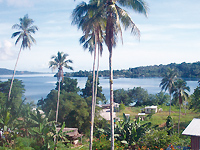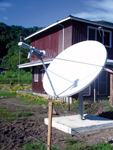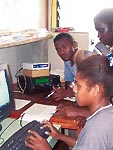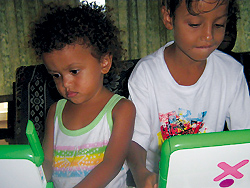|
Connecting the Solomon Islands
 PFnet/DLCP
PFnet/DLCP
A community e-mail station on the shores of an island in the country’s Western Province
|
The Solomon Islands, a country situated in the Pacific Ocean to the east of Papua New Guinea, is formed from an archipelago of hundreds of islands, covering thousands of square kilometres. With a population of about half a million scattered across this area — and speaking dozens of different languages — communication can be very difficult.
Teledensity is low. The operator Solomon Telekom is expanding its mobile services; but for now, community access facilities are likely to be the means by which most residents of low-income rural areas have contact with the wider world. Helping to build such facilities, a not-for-profit organization called People First Network, or PFnet, has set up projects that allow people to make contact through the Internet.
Narrowband network
PFnet was established in 2001 through a project of the United Nations Development Programme (UNDP) in partnership with the Solomon Islands’ Ministry of Provincial Government and Rural Development. It has received funding and technical support from the governments of Australia, China, Japan, New Zealand and the United Kingdom, as well as the European Union. PFnet uses an ultra low-cost model for creating facilities, which are all managed by their communities. It uses a grassroots approach, and the network grows as new groups come forward to request local connections.

PFnet/DLCP
It costs about USD 8000 to set up a PFnet
e-mail station like this one in Isabel Province. But there are very low running costs and no per-minute charges for use. It is also simple to add stations on a modular basis. For example, a rural clinic, bank or tourist site could include a communication component in its project
|
“The PFnet system, offering basic e-mail services, seeks to improve connectivity while dramatically reducing the prices of communication, making it affordable for low-income users and sustainable over time,” said PFnet Manager David Ma’ai. The network will help the citizens take charge of their country’s development, he added, with particular attention being paid to improving gender equality and democratic governance. “This, in concrete terms, is what bridging the digital divide means to the Solomon Islands,” Mr Ma’ai said.
The system centres on an Internet café in the capital, Honiara, that has connectivity via a VSAT (very small aperture terminal) satellite ground station. The café serves as a training facility, as well as a popular place where people can surf the Web. It is also the hub for a network of some 30 community-run e-mail stations around the country. In each one, using solar power for a simple computer and a short-wave HF radio with a modem, operators help customers to send and receive e-mails at a nominal cost. The messages are sent by radio to Honiara, and thence distributed nationally and internationally.
The e-mail system is WaveMail, developed by Schuemperlin Engineering AG of Switzerland, which is optimized to use slow radio or satellite links efficiently, but has all the functions of a full e-mail service. “The system averages about 1 or 2 kbit/s on a good connection, but that is not the point. It allows e-mail connections in the most remote places where due to high costs, terrain and scattered small populations, VSAT and other means of broadband access are not sustainable,” explained PFnet Technical Advisor David Leeming. Although the connection speed is very low, where other forms of communication do not exist or are prohibitively expensive, the e-mail stations are the best link with the outside world.
Statistics show that most e-mails are sent within the Solomon Islands and for the purpose of contacting family members. PFnet is also used by small fishing, farming and other businesses to maintain contacts with clients, suppliers and shippers. And it is a vital link in emergency communications. After a major earthquake in April 2007 near the New Georgia group of islands, an e-mail station on the island of Simbo sent the first report of a resulting tsunami to PFnet headquarters, where it was passed to the Pacific Tsunami Warning Centre in Hawaii within 30 minutes of the earthquake.
Another important use of the system is education. Students can attach their completed assignments to e-mails sent to teachers far away — and receive materials in the same way, at the rate of about 1 kilobyte per minute. In a project on the island of Choiseul, for example, 20 students were able to take part in a course from the University of the South Pacific. However, it is not possible to surf the Internet at e-mail stations. In order to expand the opportunities for online education across the Solomon Islands, in 2004 a programme began that uses the faster technology of broadband.
 PFnet/DLCP
PFnet/DLCP The VSAT antenna brings broadband Internet access to the Distance Learning Centre on the island of Makira
|
Broadband boost
The Distance Learning Centres Project has established facilities in each of the country’s nine provinces, located in rural schools. The network has become known as the Solomon Islands SchoolNet. As well as helping schoolchildren, it can also provide training for their teachers. Adult residents can take part in academic and vocational courses. And at certain times of day, the centres are open to the public for use as Internet cafés.
In cooperation with Solomon Telekom, each centre has been equipped with a satellite link to Australia via VSAT to provide high-speed broadband Internet access, as well as laptop computers, printers and scanners, and a short-wave radio. Everything is solar-powered. There is also a full-time supervisor, to help learners use the equipment and to follow online courses. Lectures can be sent live to all the centres simultaneously, and students can interact with their teachers in real time.
The project is implemented by PFnet and has been funded by the European Union. Based on the successful e-mail station model, the centres are managed under a partnership between the host schools and their communities, PFnet and the Ministry of Education.
Wireless expansion

PFnet/DLCP
Students learn how to use the PFnet e-mail facility at Vanga Rural Teacher Training College on the island of Kolombangara
|
Internet access via VSAT does not have to be limited to the building that houses a distance learning centre: it can easily be extended to surrounding sites using low-cost, terrestrial wireless solutions. PFnet has carried out a pilot project to achieve this around Marovo Lagoon, in the Western Province of the Solomon Islands.
The eastern part of the “Marovo Learning Network” comprises a solar-powered access point that has been operating since January 2008 at the top of an extinct volcano, Mount Mariu, on the island of Gatokae. This is connected to a VSAT at the distance learning centre in an island village, Bekabeka, via a 6-km, line-of-sight Wi-Fi link. There is a similar 30-km link to the vocational school at the village of Batuna, where a learning centre has been open since February 2008. Batuna is a social and economic hub of the lagoon, with a secondary school and the area’s main clinic. Wireless connectivity is thus expected to bring many benefits.
A second section of the Marovo Learning Network has been built as part of the Rural Internet Connectivity System, a programme of the regional intergovernmental organization, the Secretariat of the Pacific Community (SPC). It is intended to link up to 15 schools by wireless connections to a VSAT at the school in Patukae on Gatokae Island. Children there have also received their own computers through the One Laptop per Child (OLPC) organization (see box), which is a partner in ITU’s Connect the World initiative.

OLCP
One Laptop per Child
A trial project for the One Laptop Per Child (OLPC) initiative was launched in the Solomon Islands in July 2008 by the Ministry of Education and the Pacific Community. First to benefit were children and teachers at Batuna and Patukae primary schools on the island of Gatokae, and another local school will soon have laptops too. In total, 75 will be provided, along with training. The schools were chosen because they can take advantage of the system of Internet access via VSAT that has been created in the Marovo Lagoon area.
|
Integrating communities
For many people, especially those who are illiterate or who do not have computer skills, listening to the radio is a major means of acquiring information in their own language. “FM radio broadcasting stations co-located with PFnet e-mail stations can work together effectively,” said Mr Leeming. As well as live broadcasts, content can be downloaded via the Internet from national and overseas sources. In addition, text can be e-mailed to the station, then translated into the local language and broadcast. It is a two-way process, as listeners are encouraged to contribute to programmes too.
It is important to integrate the various elements of the Solomon Islands’ communication infrastructure in this way, Mr Leeming stressed, and thus also help residents to integrate into local and national life. Through access to the Internet, better opportunities for e-government not only improve efficiency, they also improve transparency and the ability for people in rural areas to take part in the democratic process. PFnet wants to see communication infrastructure used to consult Solomon Islanders while assisting in their development. At the same time, it can bring together diverse communities that have sometimes been in conflict.“It’s an important part of peace building,” said Mr Leeming.
|






